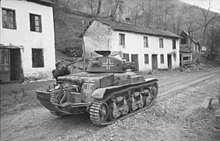Renault R-35
| Renault R-35 | |
|---|---|

Renault R-35 in an Israeli military museum (2005) |
|
| General properties | |
| crew | 2 (commander / gunner, driver) |
| length | 4.02 m |
| width | 1.87 m |
| height | 2.13 m |
| Dimensions | 10.6 t |
| Armor and armament | |
| Armor | 43 mm |
| Main armament | 37 mm L / 21 SA18 |
| Secondary armament | 7.5 mm MAC31 |
| agility | |
| drive | Renault four-cylinder 60 kW (82 PS) |
| Top speed | 20 km / h |
| Power / weight | 5.8 kW / t (7.9 PS / t) |
| Range | 130 km |
The Renault R-35 was a tank developed in France in the early to mid-1930s to replace the obsolete Renault FT from World War I.
history
With around 1700 units built, the R-35 was the most frequently used French tank in World War II . In the western campaign it was superior to most German tanks in terms of armor and armament. In 1940 the French used their tanks in many small groups, while the attacking Wehrmacht concentrated them in a few large groups. Initially, the R-35 was used in separate tank battalions of 45 tanks each, which were supposed to cooperate with the infantry divisions . These battalions were later partially combined in the newly formed armored divisions (Division Cuirassée de Réserve).
The total mass of the R-35 was 10.6 t, the maximum thickness of the armor 43 mm. The 1918 37mm cannon adopted by the FT was considered obsolete. A 7.5 mm Reibel machine gun was installed as a coaxial weapon . The crew consisted only of the driver and the commander. The latter was also a gunner and loader. A radio was usually not available, otherwise it also had to be operated by the commander.
After the victory over the French armed forces , the Wehrmacht had the R-35 converted by Alkett and used it as artillery and ammunition tugs, self-propelled guns (Panzerjäger 35R with 4.7 cm PaK 36 (t) ) and for coastal defense ( Panzerkampfwagen 35R 731 (f)) a. Some vehicles were given to Italy and Romania . Some R-35s were used by the Free French Army and the Vichy regime in North Africa and the Middle East, where they were later used by Syria .
Technical specifications
| Renault R-35 | |
| 0 General characteristics | |
| crew | two men |
| Combat weight | 9.8 t |
| spec. Ground pressure | 0.86 kg / cm 2 |
| length | 4 m |
| width | 1.85 m |
| height | 2.10 m |
| Ground clearance | 32 cm |
| Chain width | 26 cm |
| 0 armament | |
| Main armament | 3.7 cm L / 21 cannon |
| Secondary armament | a Reibel machine gun |
| Combat load HW | 58 floors |
| Combat load MG | 2500 shots |
| 0 mileage | |
| engine | Renault four-cylinder petrol engine |
| cooling | water |
| Displacement | 5.8 l |
| Bore / stroke | 120/130 mm |
| maximum rotation | 2200 rpm. |
| power | 60 kW (82 PS) |
| Liter output | 14.2 hp / l |
| Power / weight | 8.4 hp / t |
| transmission | four forward / one reverse gear |
| Speed limit road | 19 km / h |
| Fuel supply | 168 l |
| Range road | 138 km |
| Range terrain | 80 km |
| steering | Cletrac |
| Rollers | 5 |
| suspension | Rubber cylinder |
| Fording depth | 60 cm |
| 0 armor | |
| Tub bow | 32 mm |
| Tub side | 40 mm |
| Tub rear | 40 mm |
| Tub roof | 15 mm |
| Tub bottom | 14 mm |
| Tower front | 45 mm |
| Tower side | 40 mm |
| Turret stern | 40 mm |
| Tower roof | 30 mm |
maintenance
The crawler chassis required greasing every 300 km. It had mechanical problems that were taken into account when developing the Renault R-40 . The engine of the R-35 needed an oil change every 30 hours of operation; the transmission every 2000 hours. The engine was compact; this hampered troubleshooting, repair and maintenance. An engine change took 35 hours; a change of the clutch 16 hours and a change of the gearbox 14 hours.
Web links
Individual evidence
- ↑ Thomas L. Jentz : The German Armored Troop 1933-42. Podzun-Pallas Verlag, 1998, ISBN 3-7909-0623-9 , p. 277.
- ^ Rémi Fontbonne: La maintenance des engins blindés français en 1940 . In: Histoire de Guerre (journal), July / August 2003, pp. 56–65.



